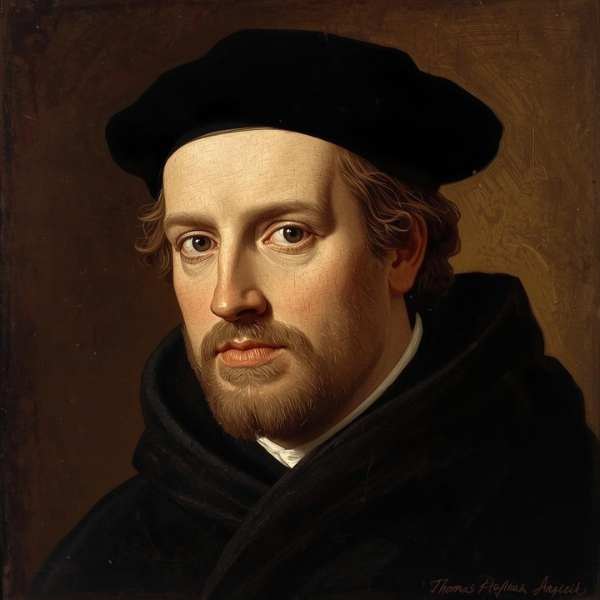
When we talk about the meeting of faith and reason, one name towers above all others: Thomas Aquinas (1225–1274). Philosopher, theologian, and Dominican friar, Aquinas accomplished what no thinker before him had dared — he reconciled Aristotle’s philosophy with Christian theology, creating one of the most enduring intellectual syntheses in Western history.
His work shaped medieval thought, influenced the Catholic Church for centuries, and continues to inspire both philosophers and believers today. Aquinas’s vision of a world where faith and reason complement rather than contradict each other remains one of humanity’s greatest intellectual achievements.
This article explores the Aristotelian-Christian synthesis crafted by Thomas Aquinas — how he integrated Greek philosophy and Christian revelation, why it was revolutionary, and how it continues to guide the relationship between science, ethics, and theology in the modern world.
⚖️ 1. The World Before Aquinas: A Clash Between Faith and Philosophy
Before Aquinas, Christian theology was largely shaped by Augustine of Hippo, whose thought drew heavily on Plato and Neoplatonism. Augustine emphasized faith, divine illumination, and the soul’s inner life, often viewing the material world as secondary.
But by the 12th and 13th centuries, Europe’s intellectual landscape began to change:
- Aristotle’s works, rediscovered through Arabic and Jewish scholars like Averroes and Maimonides, began circulating in Western universities.
- His emphasis on empirical observation, logic, and natural causes fascinated Christian scholars.
- Yet, Aristotle’s philosophy seemed to conflict with Christianity: he described an eternal universe, denied individual immortality as Christianity understood it, and saw God more as a Prime Mover than a personal deity.
Many theologians feared Aristotle’s ideas would undermine faith. Others, including Aquinas, saw an opportunity — to show that reason and revelation spoke different languages about the same truth.
🧩 2. Thomas Aquinas: The Scholar and the Saint
Thomas Aquinas was born around 1225 in Roccasecca, near Naples, Italy. At 19, he joined the Dominican Order, a new religious community focused on preaching and teaching — a bold move that shocked his noble family.
Aquinas studied under the great Albert the Great in Paris and Cologne, where he was first introduced to Aristotle’s philosophy. Rather than reject it as pagan or dangerous, Aquinas saw in Aristotle a powerful intellectual ally:
- Aristotle’s logic provided a method for rigorous argument.
- His metaphysics offered a philosophical foundation for Christian doctrines.
- His ethics and politics helped explain human purpose and morality.
Aquinas’s masterpiece, the Summa Theologica, became the cornerstone of Christian philosophy. Written between 1265 and 1274, it aimed to explain all Christian teaching using both revelation and rational argument — a true harmony between Athens and Jerusalem.
📚 3. The Aristotelian Foundation: Reason, Nature, and Order
To understand Aquinas’s synthesis, we must first grasp what Aristotle taught and why it mattered.
🧠 Aristotle’s View of the World
Aristotle believed the universe is rationally ordered and that every being has a purpose — what he called its telos (end or goal). His philosophy is built on several key ideas:
- Empiricism: Knowledge begins with sensory experience.
- Form and Matter: Everything is a combination of form (essence) and matter (substance).
- Four Causes: Every event has four explanations — material, formal, efficient, and final causes.
- Prime Mover: A perfect, immaterial being that sets all things in motion but remains unchanged.
This worldview emphasized reason, observation, and the search for natural explanations, which fascinated Aquinas. But unlike Aristotle, Aquinas believed the world was created by God, not eternal — and that the human soul is immortal.
✝️ Christianity’s Challenge
Christianity taught that:
- The world was created by a personal God out of nothing (ex nihilo).
- Humans were made in God’s image, endowed with free will.
- The soul survives death and is destined for eternal life.
- Truth is ultimately revealed by God, not just discovered by reason.
The task before Aquinas was monumental: how to unite Aristotle’s philosophy of reason and nature with Christian revelation and salvation — without betraying either.
🌟 4. The Great Synthesis: Faith and Reason in Harmony
Thomas Aquinas’s central conviction was simple but profound:
“Truth cannot contradict truth.”
This means that reason and faith come from the same divine source, and thus, when properly understood, they cannot oppose one another.
🧭 a) Reason Leads to Faith
Aquinas believed that human reason can discover many truths about God — for example, His existence, unity, and perfection — without relying on Scripture. These truths are “natural theology.”
He offered five logical proofs for the existence of God, known as the “Five Ways” (Quinque Viae):
- The Argument from Motion — Everything in motion must be moved by something else; therefore, there must be a First Mover — God.
- The Argument from Causation — Every effect has a cause; there must be a First Cause — God.
- The Argument from Contingency — Because things exist and perish, there must be a Necessary Being — God.
- The Argument from Degrees of Perfection — The existence of good, better, and best implies a source of ultimate perfection — God.
- The Argument from Design (Teleology) — The order and purpose in nature suggest an intelligent designer — God.
These arguments reflect Aristotelian logic, yet serve a Christian purpose: to show that faith rests on a rational foundation.
✨ b) Faith Completes Reason
While reason can reach truths about God, faith reveals mysteries that reason alone cannot — such as the Trinity, Incarnation, and Resurrection.
Aquinas wrote:
“Grace does not destroy nature but perfects it.”
In other words, faith builds upon reason, elevating human understanding toward divine truth. Philosophy prepares the mind for revelation, but theology leads it to salvation.
This elegant balance preserved the dignity of human reason while affirming the supremacy of divine grace.
🕊️ 5. The Nature of Humanity: Body, Soul, and Purpose
For Aquinas, the human being is not a soul trapped in a body (as Plato taught), but a union of body and soul — a concept taken directly from Aristotle’s hylomorphism.
- The soul is the form of the body — the principle that gives life and meaning.
- The body is not evil or inferior, but an essential part of human identity.
This view dignified human existence, affirming that reason, morality, and even physical life are sacred expressions of divine purpose.
Aquinas also developed a profound theory of ethics, inspired by Aristotle’s Nicomachean Ethics, but centered on God as the ultimate good.
- Every human action aims at happiness (beatitudo).
- True happiness is not found in wealth, power, or pleasure — but in union with God.
- Virtue, therefore, is the habit that orders human desires toward divine love.
In Aquinas’s moral philosophy, reason shows the way, but faith gives the destination.
⚖️ 6. Natural Law: Morality Rooted in Reason
One of Aquinas’s most influential contributions is his doctrine of Natural Law, still foundational in philosophy, law, and ethics today.
According to Aquinas:
“The natural law is nothing else than the rational creature’s participation in the eternal law.”
This means that the moral order is built into creation and can be known through reason and conscience. Humans, by nature, can understand basic moral truths such as:
- Do good and avoid evil.
- Respect life.
- Seek truth.
- Live in society and promote justice.
Natural law provides the bridge between philosophy and theology, allowing both believers and non-believers to discuss ethics on rational grounds.
In a world increasingly divided over moral relativism, Aquinas’s belief that reason reveals universal moral truths remains remarkably relevant.
🏛️ 7. The Legacy of the Aristotelian-Christian Synthesis
Thomas Aquinas’s work transformed the intellectual world of the Middle Ages. His synthesis of Aristotle and Christianity laid the foundation for Scholasticism, the great tradition of medieval learning centered in universities like Paris, Oxford, and Bologna.
🧩 Influence on the Church and Beyond
- The Catholic Church adopted Aquinas’s theology as its philosophical framework, especially after the Council of Trent (1545–1563).
- In 1879, Pope Leo XIII’s encyclical Aeterni Patris officially endorsed Thomism as the foundation of Catholic philosophy.
- His ideas shaped Western law, education, and politics, particularly through Natural Law theory.
- Even secular philosophers, from Descartes to Kant, engaged with Aquinas’s arguments about being, morality, and knowledge.
🌍 Relevance Today
In the 21st century, Aquinas’s synthesis speaks to ongoing debates about:
- Science and religion — his harmony of faith and reason challenges the false conflict between them.
- Ethics and human rights — his idea of Natural Law supports universal dignity.
- Philosophy of mind — his body–soul unity anticipates modern discussions about consciousness and identity.
Aquinas’s worldview offers a hopeful message: that truth is one, and that both reason and revelation are paths leading toward it.
🕯️ 8. Thomas Aquinas: The Quiet Giant of Thought
Despite his towering intellect, Aquinas was known for his humility. He never sought fame; he sought understanding. Toward the end of his life, after a mystical vision during Mass, he stopped writing altogether, saying:
“All that I have written seems like straw compared with what has now been revealed to me.”
He died in 1274, leaving behind not only monumental works but also a vision of faith grounded in logic, order, and love.
In 1323, the Church canonized him as a saint, and in 1567, Pope Pius V declared him a Doctor of the Church. His feast day, January 28, remains a celebration of both intellect and spirituality.
🌟 Conclusion: The Harmony of Athens and Jerusalem
Thomas Aquinas’s Aristotelian-Christian synthesis stands as one of the greatest intellectual achievements in history. He proved that reason and revelation, science and faith, philosophy and theology need not be enemies — they are two lights illuminating the same truth.
In a time when many see conflict between knowledge and belief, Aquinas reminds us that:
- Reason is a path to God.
- Faith gives meaning to reason.
- Truth is indivisible — whether discovered through the mind or revealed through grace.
More than seven centuries later, Aquinas’s words still echo with power:
“To one who has faith, no explanation is necessary. To one without faith, no explanation is possible.”
And yet, he would insist — keep explaining, keep questioning, keep seeking. For in the search for truth, faith and reason forever walk hand in hand.
📚 Sources
- Thomas Aquinas, Summa Theologica
- Thomas Aquinas, Summa Contra Gentiles
- The Cambridge Companion to Aquinas, Cambridge University Press
- Stanford Encyclopedia of Philosophy – Thomas Aquinas
- Britannica – Thomas Aquinas: Biography, Philosophy, and Theology
- Oxford University Press – Aquinas and the Rediscovery of Aristotle
- Pope Leo XIII, Aeterni Patris (1879)

